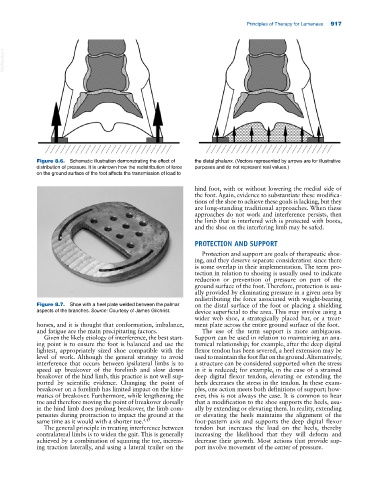Page 951 - Adams and Stashak's Lameness in Horses, 7th Edition
P. 951
Principles of Therapy for Lameness 917
VetBooks.ir
Figure 8.6. Schematic illustration demonstrating the effect of the distal phalanx. (Vectors represented by arrows are for illustrative
distribution of pressure. It is unknown how the redistribution of force purposes and do not represent real values.)
on the ground surface of the foot affects the transmission of load to
hind foot, with or without lowering the medial side of
the foot. Again, evidence to substantiate these modifica-
tions of the shoe to achieve these goals is lacking, but they
are long‐standing traditional approaches. When these
approaches do not work and interference persists, then
the limb that is interfered with is protected with boots,
and the shoe on the interfering limb may be safed.
PROTECTION AND SUPPORT
Protection and support are goals of therapeutic shoe-
ing, and they deserve separate consideration since there
is some overlap in their implementation. The term pro-
tection in relation to shoeing is usually used to indicate
reduction or prevention of pressure on part of the
ground surface of the foot. Therefore, protection is usu-
ally provided by eliminating pressure in a given area by
redistributing the force associated with weight‐bearing
Figure 8.7. Shoe with a heel plate welded between the palmar on the distal surface of the foot or placing a shielding
aspects of the branches. Source: Courtesy of James Gilchrist. device superficial to the area. This may involve using a
wider web shoe, a strategically placed bar, or a treat-
horses, and it is thought that conformation, imbalance, ment plate across the entire ground surface of the foot.
and fatigue are the main precipitating factors. The use of the term support is more ambiguous.
Given the likely etiology of interference, the best start- Support can be used in relation to maintaining an ana-
ing point is to ensure the foot is balanced and use the tomical relationship; for example, after the deep digital
lightest, appropriately sized shoe compatible with the flexor tendon has been severed, a heel extension may be
level of work. Although the general strategy to avoid used to maintain the foot flat on the ground. Alternatively,
interference that occurs between ipsilateral limbs is to a structure can be considered supported when the stress
speed up breakover of the forelimb and slow down in it is reduced; for example, in the case of a strained
breakover of the hind limb, this practice is not well sup- deep digital flexor tendon, elevating or extending the
ported by scientific evidence. Changing the point of heels decreases the stress in the tendon. In these exam-
breakover on a forelimb has limited impact on the kine- ples, one action meets both definitions of support; how-
matics of breakover. Furthermore, while lengthening the ever, this is not always the case. It is common to hear
toe and therefore moving the point of breakover dorsally that a modification to the shoe supports the heels, usu-
in the hind limb does prolong breakover, the limb com- ally by extending or elevating them. In reality, extending
pensates during protraction to impact the ground at the or elevating the heels maintains the alignment of the
same time as it would with a shorter toe. 4,17 foot‐pastern axis and supports the deep digital flexor
The general principle in treating interference between tendon but increases the load on the heels, thereby
contralateral limbs is to widen the gait. This is generally increasing the likelihood that they will deform and
achieved by a combination of squaring the toe, increas- decrease their growth. Most actions that provide sup-
ing traction laterally, and using a lateral trailer on the port involve movement of the center of pressure.

